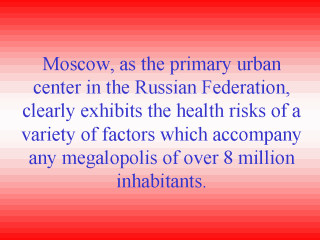 |
In sum, Moscow,
appears to have an overall health profile distinct from the Russian Federation mean.
Although the wealthiest region, it is by no means the healthiest. The infant mortality
rate, a traditionally sensitive indicator of deprivation, was higher in Moscow than in
other regions; birth and death ratios are substantially greater than in the Russian
Federation; congenital anomalies at birth were greater; the highest life expectancy in the
Russian Federation dropped to Russia’s mean after macro economic reforms began in 1992;
chronic disease morbidity is higher than the mean for Russia, especially for
cardiovascular diseases; and almost a decade after Perestroika collapsed, post-Soviet
Moscow is the STD/HIV capital of Russia. Between 1991 – 1997, syphilis increased by a
factor of ten; there were 16,986 new cases registered. |
